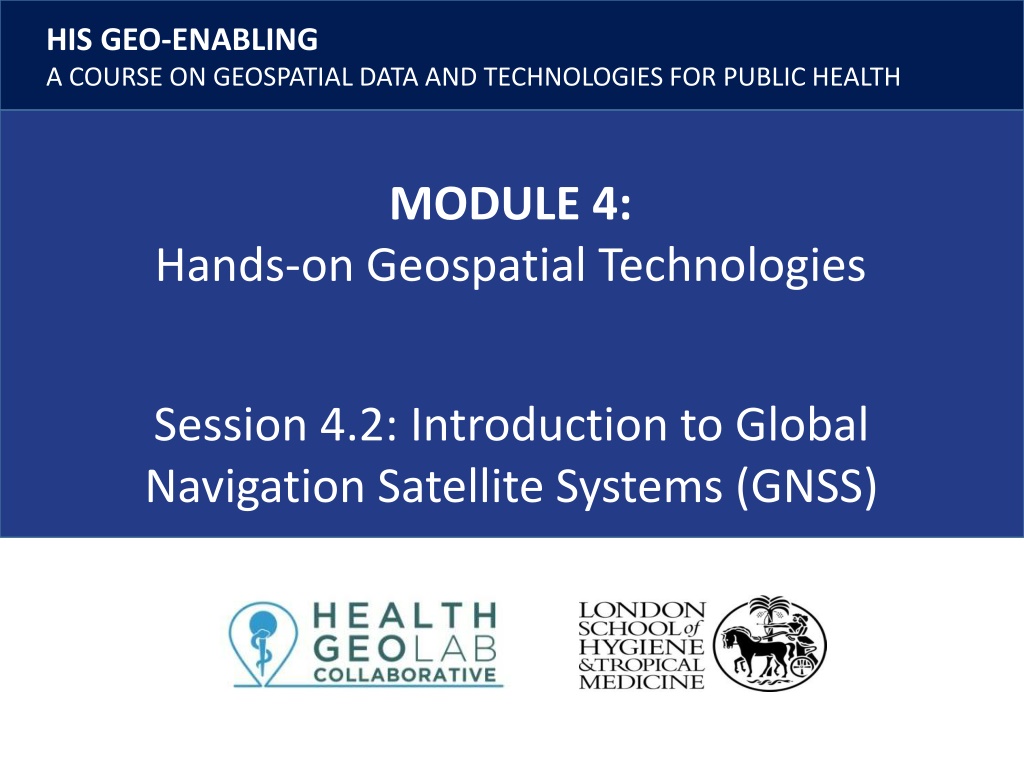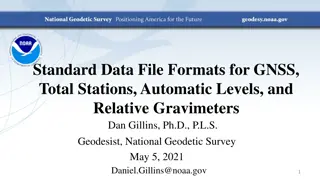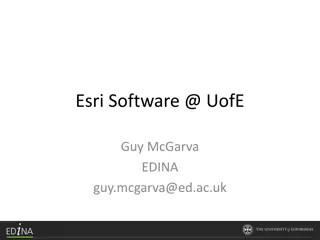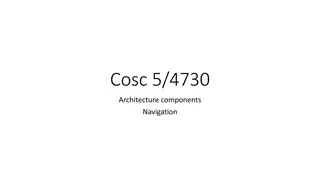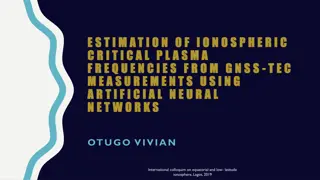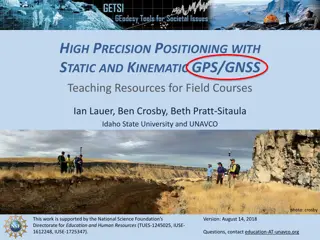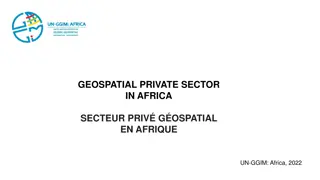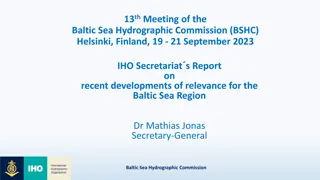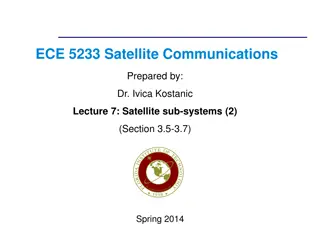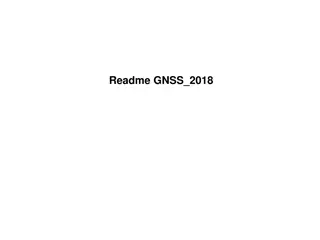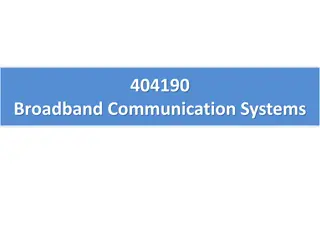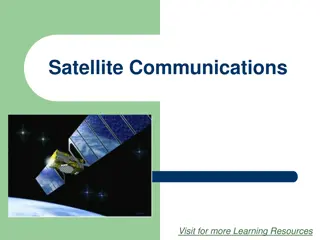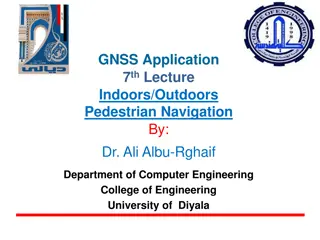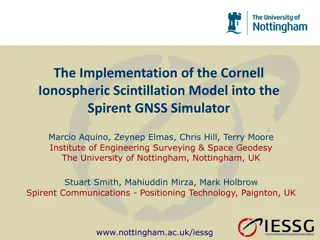Understanding Global Navigation Satellite Systems (GNSS) in Geospatial Data for Public Health
Explore the key terms such as accuracy, GLONASS, GPS, precision, scale, and more in this session on GNSS technology. Understand how GNSS works, the constellation of satellites involved, and the different satellite navigation systems like GPS, GLONASS, BeiDou, and Galileo that provide autonomous geo-spatial positioning. Learn about the functions of identifier, almanac data, and ephemeris data in determining satellite location, and discover the significance of GNSS in public health applications.
Download Presentation

Please find below an Image/Link to download the presentation.
The content on the website is provided AS IS for your information and personal use only. It may not be sold, licensed, or shared on other websites without obtaining consent from the author. Download presentation by click this link. If you encounter any issues during the download, it is possible that the publisher has removed the file from their server.
E N D
Presentation Transcript
HIS GEO-ENABLING A COURSE ON GEOSPATIAL DATA AND TECHNOLOGIES FOR PUBLIC HEALTH MODULE 4: Hands-on Geospatial Technologies Session 4.2: Introduction to Global Navigation Satellite Systems (GNSS)
Key terms used in this session Accuracy: The degree to which a measured value conforms to true or accepted values. Accuracy is a measure of correctness. GLONASS: Acronym for Global Navigation Satellite System. The Russian counterpart of the United States Global Positioning System. GNSS: Acronym for Global Navigation Satellite System, and is the standard generic term for satellite navigation systems that provide autonomous geo-spatial positioning with global coverage. This term includes e.g. the GPS, GLONASS, Galileo, Beidou and other regional systems. 2
Key terms used in this session GPS: Acronym for Global Positioning System. A system of radio- emitting and -receiving satellites used for determining positions on the earth. Developed and operated by the U.S. Department of Defense, the system is used in navigation, mapping, surveying, and other applications in which precise positioning is necessary. Precision: The number of significant digits used to store numbers, particularly coordinate values. Precision measures exactness. Scale: The ratio or relationship between a distance or area on a map and the corresponding distance or area on the ground, commonly expressed as a fraction or ratio. A map scale of 1/100,000 or 1:100,000 means that one unit of measure on the map equals 100,000 of the same unit on the earth. 3
Global Navigation Satellite Systems (GNSS) Constellation of satellites providing signals from space that transmit positioning and timing data to GNSS receivers. The receivers then use this data to determine location. 4
Global Navigation Satellite Systems There are different satellite navigation systems providing autonomous geo-spatial positioning at present: GPS, GLONASS, BeiDou, and Galileo 5
How does it work? - Identifier - Almanac Data (status & orbital info to calculate which satellites are visible) - Ephemeris Data (precise orbital info to calculate satellite location) 6
How does it work? If only 1 signal ? ? ? ? ? ? ? 7
How does it work? If only 2 signals ? ? ? ? ? ? ? ? 8
How does it work? If 3 signals If 4 signals Reason why you need at least 4 satellites signal to get a good reading 9
Source of signal errors Poor PDOP Poor PDOP Good PDOP Good PDOP PDOP: Positional Dilution of Precision PDOP: Positional Dilution of Precision 10
Source of signal errors Accuracy: 69 m Accuracy: 46 m Accuracy: 44 m Accuracy: 19 m Accuracy: 14 m Accuracy: 12 m Accuracy: 12 m Accuracy: 7 m Better to have a good dispersion and looking at the accuracy measure given by the device 11
Source of signal errors 2 2 1 1 Signal Multipath Signal Multipath Take the reading in the most open space possible 13
Which device to use? Large choice / different prices! Minimum requirements: 1. Allows to be set up as follow: a. Position format: hddd.ddddd b. Map datum: WGS84 c. Map Spheroid WGS84 d. Distance and speed: Metric 2. Provide a reading with at least 5 digits to reach a level of precision down to the meter 3. Display the following information: a. Number of received satellite signals b. Accuracy measure 4. Having access to both the GPS and GLONASS constellations is a plus 14
Unit Setting Should match the data specifications Taking a reading Coordinates GPS and GLONASS on Accuracy value Satellite position Number of received satellite signals GNSS device Mobile phone + app 15
Why use latitude and longitude? Why use latitude/longitude (Decimal degrees)? Most comprehensive and powerful method of georeferencing Standard, stable, unique, infinitely fine resolution Uses a well-defined and fixed reference frame Based on Greenwich (Prime) Meridian and Equator Most used in geospatial technologies 16
Scale, Accuracy, and Precision 15 m Recommended 17
Data collection methods The one used for Exercise 4.A Without GNSS enabled devices Uses GNSS enabled devices 18 https://www.healthgeolab.net/DOCUMENTS/Guide_HGLC_Part2_4_2.pdf
Importance of SOP and Training It is important to have and follow Standard Operating Procedure and train in using the device. 1. 2. Description of the device How to use the device (buttons, batteries, ) How to set it up Step by step process to collect the reading 3. 4. Guide_HGLC_Part2_4_2.pdf 19
Importance of SOP and Training When you are done with the stand alone device On site, between data collection points For longer period of time Remove the batteries from the device Store the device in A dry place 20
Summary To summarize: Choose the appropriate device/method Set the unit as per the data specifications Use a pre-established SOP Signal lost indoors and reflected off buildings and other near by objects => choose an open space Takes time to calibrate and get accurate reading wait 1 minute to finalize coordinates Minimum 4 satellites Collect coordinates with 5 digits after the decimal point Ethics of mapping households and GPS tracking !!! 21
Android devices and GPS Essentials GPS Essentials is a free application available for Android- based devices with a built-in GNSS receiver. It can be used as an alternative to dedicated GPS devices when collecting geographic coordinates as it complies with the specifications discussed in the previous slides. 22
Preparation for Exercise 4.A Separate document Installation guide for GPS Essentials SOP to follow and data collection form to use when collecting geographic coordinates using an android phone and GPS Essentials Proceed to Exercise 4.A Exercise 4.A 23
